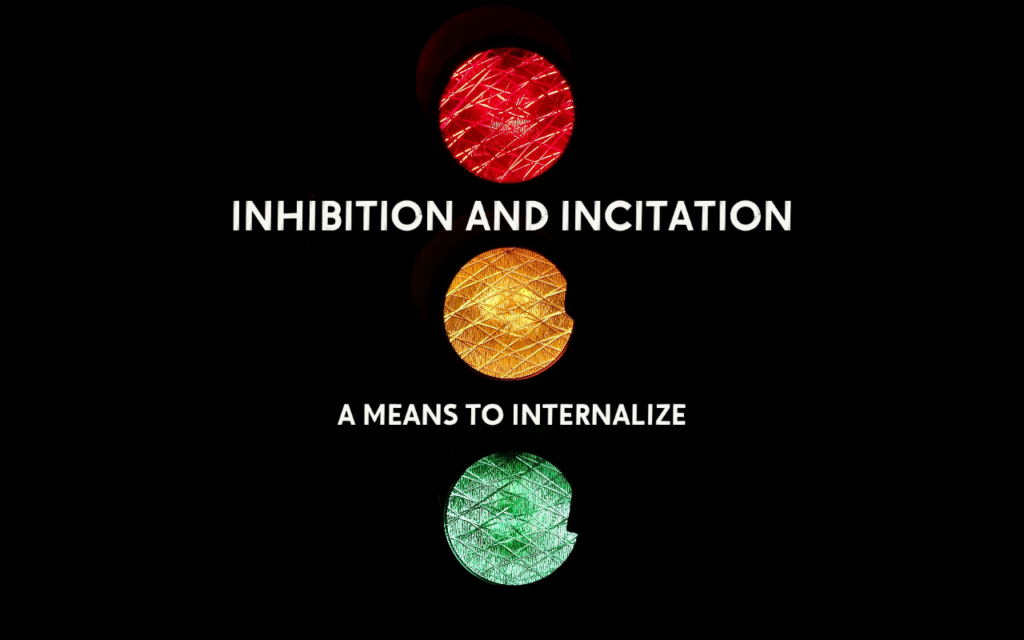
Incitation and Inhibition: A Means to Internalize
by Jeremy Dittus and Eiko Ishizuka
The Dalcrozian strategy/technique of incitation and inhibition exists in virtually every reaction exercise we do in eurhythmics, solfège, and improvisation. Simply put, incitation describes the desire to do something while inhibition describes the feeling of suppressing or denying that desire. Because of their symbiotic nature, incitation and inhibition typically happen in succession; rarely does one exist without another. On page 67 of Rhythm, Music and Education1, Jaques-Dalcroze alludes to this:
Musical rhythm consists of movements and repressions of movements. Musicians with irregular rhythms are those whose muscles are too slow or too quick in responding to mental orders, who lose time in submitting, one movement for another, or who cannot check themselves in time, or else check themselves too hastily, ignoring the art of preparing repressions of movement.
While incitation and inhibition are somewhat abstract conceptually, it is the feeling that they manifest that we find to be most valuable.
Incitation is the sensation that inspires the body to move or to do.
It is the sensation of readiness that is stimulated by an impulse, either external or internal. Sometimes incitation has been translated from French as “excitation”; incitation and excitation are interchangeable terms. Here are some examples of incitation in daily life:
- When we are at an intersection and we see the light change from red to green, we often experience an impulse to go.
- Imagine a sprinter at the starting line of the hundred-meter dash: athletes poised in their blocks, ready to push off the moment they hear the starting gun. When they hear the gun go off, they sprint down the track.
- When we hear music that we love, we involuntarily begin tapping our toes or initiate moving in time with the music without even knowing it.
Inhibition is the sensation that prevents action from taking place.
In short, inhibition is the desire to stop. It is the act of preventing an action from taking place, often withholding energy, movement, and momentum. Here are some examples of inhibition in daily life
- When we’re about to enter a crosswalk right as the light turns red, we suddenly stop and suppress our body weight from stepping forward.
- In our hundred-meter dash example above, it is the sensation that keeps the runner from sprinting until they hear the sound of the starting gun.
- When we hear a song in our head that we love, and we want to sing aloud, but we’re in a library, so we can’t.
In the Dalcroze hall, incitations and inhibitions result in the internalization of musical concepts because to create the change demanded, the focus of the individual turns inward. By suppressing the desire to do a given task, one often continues the task in their imagination in any number of ways. It is this same imagination that is summoned when we say to someone, “Sing a major scale,” and they hear the pitch collection in their head before they even produce a sound. Another example is when a pianist is looking at a musical score and they can imagine their hands producing those specific sounds on the keyboard. In the end, incitation and inhibition is part of the process to develop automatisms because of the focus on internalization.
One important quality of incitations and inhibitions is that they rarely exist in isolation from one another. Anytime there is an inhibition, an incitation is present; anytime an incitation occurs, an inhibition exists too. Because of this, every moment of incitation and inhibition is multilayered; in some cases, there can be multiple possibilities of analyzing incitation and inhibition.
Labeling incitations and inhibitions can be complicated because Dalcroze strategies/techniques rarely exist in a vacuum: They often are coupled in various ways. For example, continuous canons are a type of reaction, but they also involve dissociation/association and incitation/inhibition. As you read more about the examples that follow, keep in mind that there may be other types of strategies and techniques at play. We’ll notate some of them in our discussions, but you might imagine others too. We discuss reactions, dissociations, canons, complementary rhythm, and replacement activities here, but this list is not exhaustive. At the end, we list some examples outside of the typical Dalcroze strategies and techniques.

Examples of Inhibition and Incitation
Reactions
Any time we are motivated to move, gesture, sing, or play something (anything!), this is a manifestation of incitation. This could be the result of a signal (a verbal signal, an aural/musical signal, a visual signal, or a tactile signal, etc.). At the moment of change, there is some kind of inhibition. Here are some examples of reaction activities (quick reactions) that showcase incitations and inhibitions.
Verbal Reactions
Step and clap the same pulse.
If you hear the verbal signal from the teacher, “hands,” stop clapping the hands, but continue stepping. At the next signal, “hands,” resume clapping. The first moment the signal is heard, you inhibit the hands from continuing their normal activity while continuing the motion of the feet. Consequently, the second time the signal is heard, you incite the hands to clap in time with the feet.
If you hear the verbal signal, “feet,” stop stepping, but continue clapping the hands. At the next signal, “feet,” resume stepping. The first moment the signal is heard, you inhibit the feet from continuing their normal activity while continuing the motion of the hands. Consequently, the second time the signal is heard, you incite the feet to step in time with the hands.
This exercise, along with most movement exercises that demand starting and stopping of some kind, requires a fair amount of coordination and balance. Many exercises with the goal of coordination/disordination or that challenge our balance will have some element of incitation/inhibition associated with it.
Another starting and stopping activity can be done using Do-to-Do scales. For example, a student sings an F major Do-to-Do scale continuously up and down. At the teacher’s command, “hip,” the student stops singing out loud but the scale continues in their inner ear. When the teacher calls “hip” again, the student resumes singing wherever the scale ended up at that moment. A variation on this game is to have the teachers call “hop.” At once, the student stops singing, but the music doesn’t continue internally. When the teacher calls “hop” again, the student continues on the very next pitch.
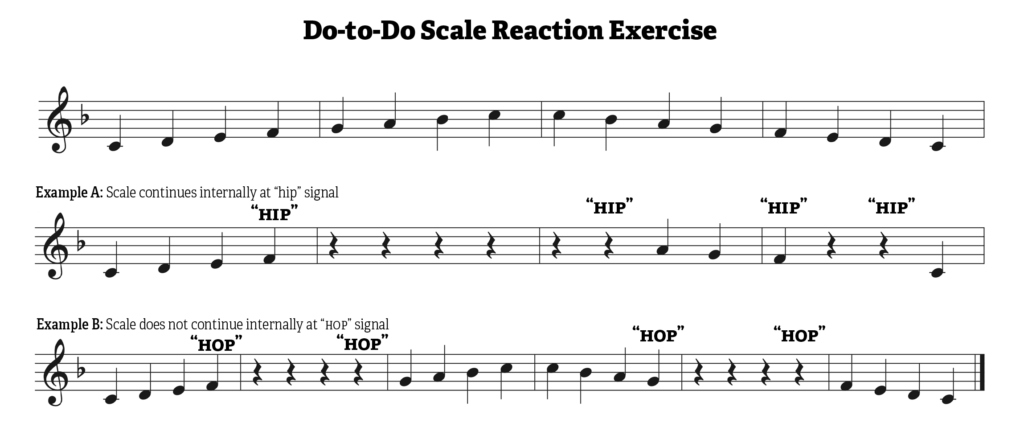
Aural/Musical Reactions
Go for a skip and bounce/catch a ball in two-time to music played in both low and high registers on the piano.
If the teacher plays low music only, just skip, but hold the ball, do not bounce it. Upon hearing the shift in register, you incite your hands to hold tightly to the ball; at the same time, you inhibit your hands from letting go while also inhibiting your feet from stopping. When you hear the upper register return to the musical texture, then you resume bouncing and catching the ball to the beat. At this moment, you are incited to bounce/catch the ball again with the music.
If the teacher plays high music only, stop skipping and bounce/catch the ball in time with the music. To stop your feet, you are incited to shift weight to stop with grace and ease (depending, of course, on when the signal was played and when you registered the signal). Simultaneously, you must withhold the desire to keep moving: inhibition in action! For as long as the music plays in the upper register, you inhibit the locomotion, but as soon as it resumes, you are incited to move with it.
Visual Reactions
While seated, sing “Twinkle, Twinkle, Little Star,” gesturing the notes in physical space. For example, gesture lowest notes on your knees; as each note gets progressively higher, move your hand up higher in physical space. The highest note, scale degree six, could be as high as your head.
If the teacher stands up tall and proud, continue singing using a full, strong voice. However, as the teacher begins to crouch down lower and lower, sing more gently. If they touch the ground, don’t sing aloud. However, the hands always move with the song, no matter what!
Same game, except each time the teacher changes levels, students change the quality of singing (strong for high and gentle for low, etc.). Students experience incitation as they associate tall movement with forte singing and small movement with piano singing; they experience inhibition as they may want to maintain the previous quality of singing instead of moving on to the next one.
In addition, there may be an inhibition to stop moving the hand that gestures the notes in physical space! When the teacher finally touches the ground, the students must incite their hands to keep moving through space and time while inhibiting their voices from producing any sound at all. When the teacher stops touching the ground, the students must incite their singing voices to resume singing exactly where their hands are in space and time!

Tactile Reactions
One student sits at the piano while the teacher stands behind them, tapping rhythms on the student’s shoulders. Whatever rhythms are tapped, the student improvises at the piano. Additionally, the articulation of how the teacher taps the rhythms should be reflected in the improvisation of the student at the piano.
When the student first feels the rhythms and the articulations on their shoulders, they are incited to begin realizing the patterns. Of course, there could be some internal inhibition present because the student may not know how to realize the patterns or express what they feel. But that is a separate issue that often comes up in improvisation of any kind.
When the teacher changes to a new pattern, the student must inhibit themselves from continuing the previous pattern and exercise incitation to play the new one. Ideally this happens without stopping the musical flow of the exercise. If that happens, then most likely there will be a brief moment when the teacher is tapping a pattern that is different from what the student is playing. This is an example of another Dalcroze strategy/technique: dissociation.
The teacher might tap a rhythmic ostinato on one shoulder while tapping a different pattern on the other shoulder! Again, this type of dissociation involves a fair amount of inhibition/incitation because of the nature of dissociations in general.
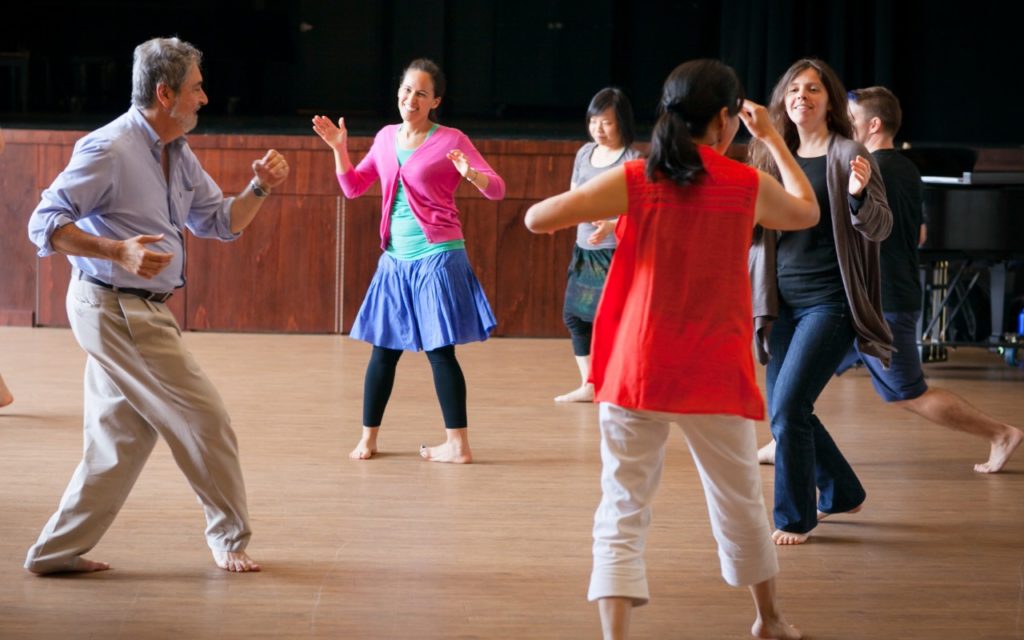
Photo by David Tucker.
Dissociations
Virtually all rhythmic dissociations involve inhibition and incitation of some kind. In the first example above, the student is incited to change to the new pattern when they feel the new pattern tapped on their shoulders. But they may experience inhibition while they process what they sense on their shoulders while performing the previous pattern. In the second example, the student is incited to play different rhythms in each hand while inhibiting those patterns from interfering with one another in their improvisation.
Canons
Incitation and inhibition occur in interrupted and continuous canons of all kinds because these exemplify the start/stop activities previously discussed along with dissociations. For example, movement canons are a lot of fun and demonstrate incitation and inhibition. A leader in the class chooses to move in a creative and interesting way, perhaps a unique skip; the rest of the students remain still. As soon as the leader changes to a different movement, maybe a crawl, the class begins to move the skip. When the leader changes from a crawl to a march, the class changes to a crawl. The game continues until the leader stops moving and says, “Thank you!”
Each time the student changes to a new movement, there is simultaneously an inhibition to not move the gestures they see and an incitation to move whatever was done previously. In a more challenging example, the realization of “A Ram Sam Sam” as a three-voice canon (step one voice, clap it two measures later, and sing it four measures later), offers an extraordinary level of dissociation for the mover. It also showcases how one must incite the different parts of their body to perform the voices and inhibit them from interfering with one another.

Another way to use “A Ram Sam Sam” is to have the students sing the tune, but they only move during parts of the melody. For example, they sing the tune but remain in place until they hear the “Gooli” notes; when this part of the song arrives, they may step trotting notes (eighth-notes); once the “Goolis” end, then they freeze. Repeat the same game with the “Ralphis” (step half-notes) and the “Ram Sams” (quarter-notes). You can use this game as a canon or simply as a melody to sing on its own.
Complementary Rhythm
Other examples of incitation and inhibition include complementary rhythm exercises. For example, clap the rhythm below:

Then, step the complementary rhythm at the beat level:
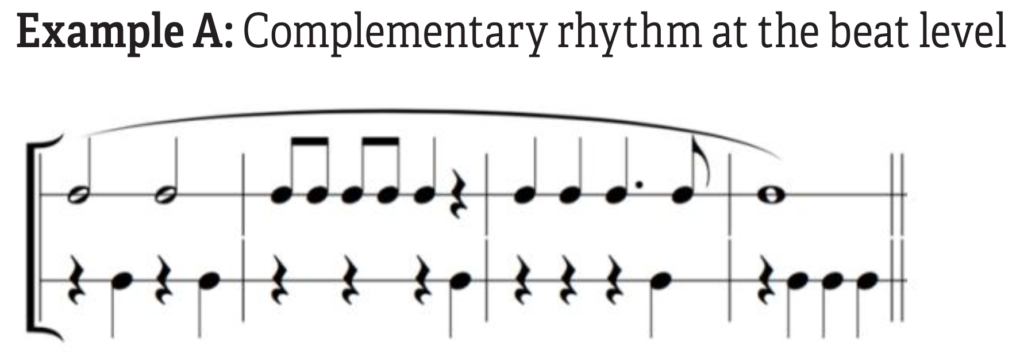
Repeat, but now step the complementary rhythm at the division level:

Because complementary rhythms engage in dissociations at some level, they also involve incitations and inhibitions. By engaging in complementary rhythm activities, the inhibitions inherent within the activity invite us to internalize the pulses of different values that reside inside rhythmic patterns.
Replacement Activities
Another example of incitation and inhibition involves replacement activities. Here, we see more of those activities of a stop/start nature. For example, students might be asked to step the rhythm of “Frère Jacques.” However, every time they hear the grouping of four divisions, they replace it with an amphibrach rhythm. Again, this type of inhibition requires that students feel the four pulses of eighth notes while simultaneously stepping the amphibrach pattern, which helps us to internalize the patterns better.

Other Examples
Incitation/inhibition can exist in contexts outside of traditional Dalcroze strategies/techniques. For example, each time the teacher plays an introduction for locomotor movement such as jogging (two eighth-notes), there is incitation/inhibition at play. Imagine that the teacher plays an introduction for a jog. While the students listen, they inhibit themselves from starting to move until the end of the introduction. At the end of the introduction, they are incited to jog!
Incitation and inhibition could also occur when we want to perform two or more tasks in succession. The teacher might ask a student to clap beats and then walk beats in a repeated pattern or systemization.

Each time there is a shift from clapping to walking, there may be an internal preparation in anticipation of changing from clapping to walking. The internal desire to change manifests at the end of clapping when the body begins to lean forward in preparation for the first step with ease and good flow. At the same time, the hands may wish to continue clapping; even without a signal for change, there can be a sensation of inhibition present because the body may want to continue clapping. Yet inhibition aims to suppress this desire.
Conversely, as the body readies to stop stepping, the weight of the body begins to shift near the end of the last step so the body can pause with control and balance. This is incitation at work; it encourages locomotion to cease and clapping to begin. Often there is momentum and inertia pushing the body forward through time and space; this makes it a challenge to stop. This is where inhibition enters to engage the muscles and prevent any extra motion forward.
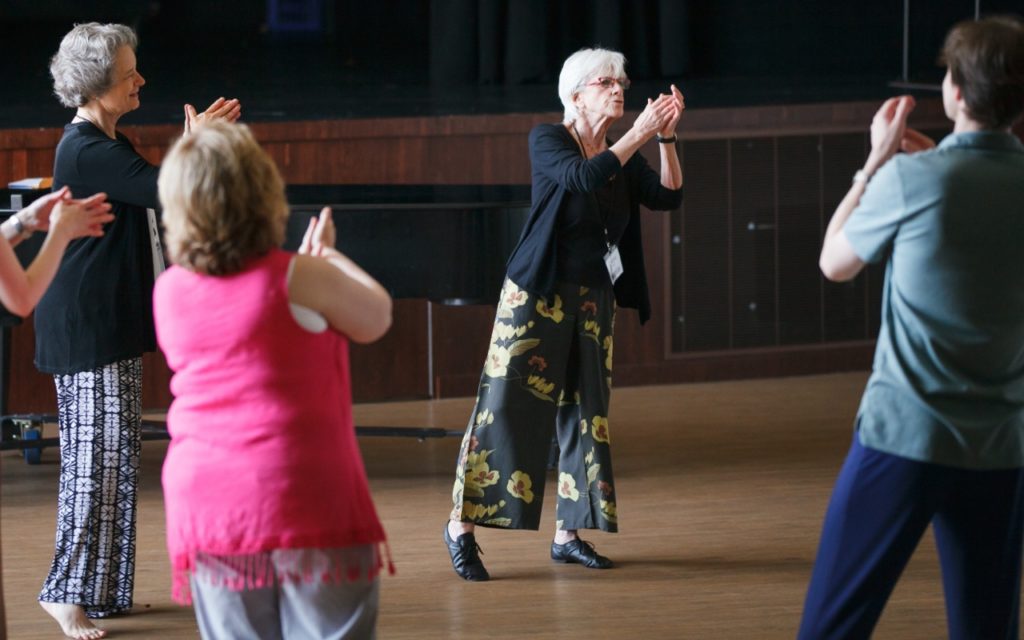
Summary
The notion of incitation and inhibition offers the Dalcroze instructor one of the most powerful means of instructing students to internalize musical concepts, which makes it so useful.
As Dalcroze put it on page 62 of Rhythm, Music and Education2:
The aim of all exercises in eurhythmics is to strengthen the power of concentration, to accustom the body to hold itself, as it were, at high pressure in readiness to execute orders from the brain, to connect the conscious with the subconscious, and to augment the subconscious faculties with the fruits of a special culture designed for that purpose.
from Rhythm, Music and Education
But perhaps the most wonderful thing about it is the pure joy inherent in these activities, especially when we overcome the obstacles incitation and inhibition can present, and ultimately achieve success! When we finally meet the challenges presented in incitation and inhibition activities, we experience the real joy of ownership and accomplishment.
Endnotes
- 1Émile Jaques-Dalcroze, Rhythm, Music and Education, trans. Harold Rubenstein (London: The Dalcroze Society, 1921).
- 2Émile Jaques-Dalcroze, Rhythm, Music, and Education, trans. Harold Rubenstein (London: The Dalcroze Society, 1921).
This article was originally published in the Fall 2022 issue of Dalcroze Connections, Vol. 7 No. 1.